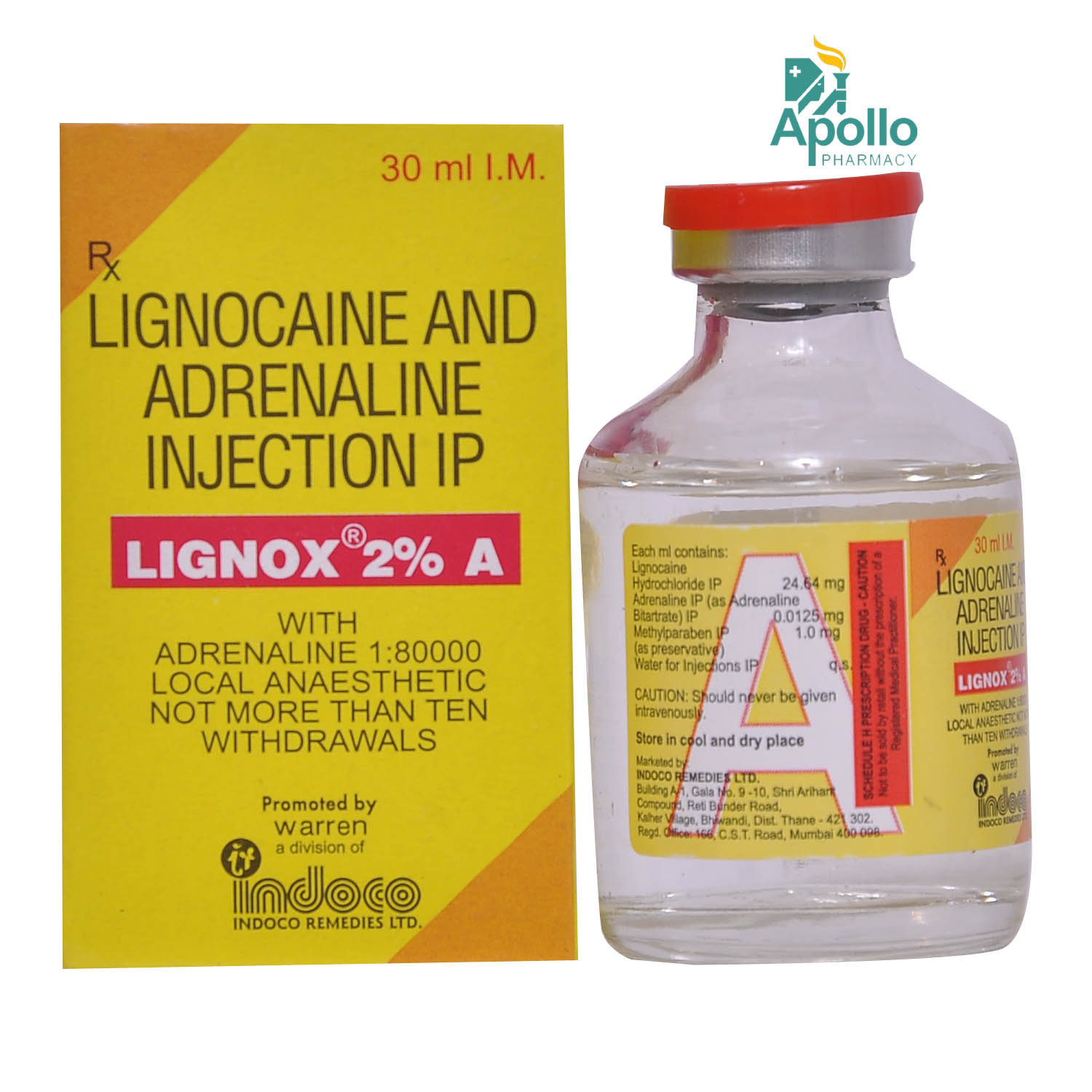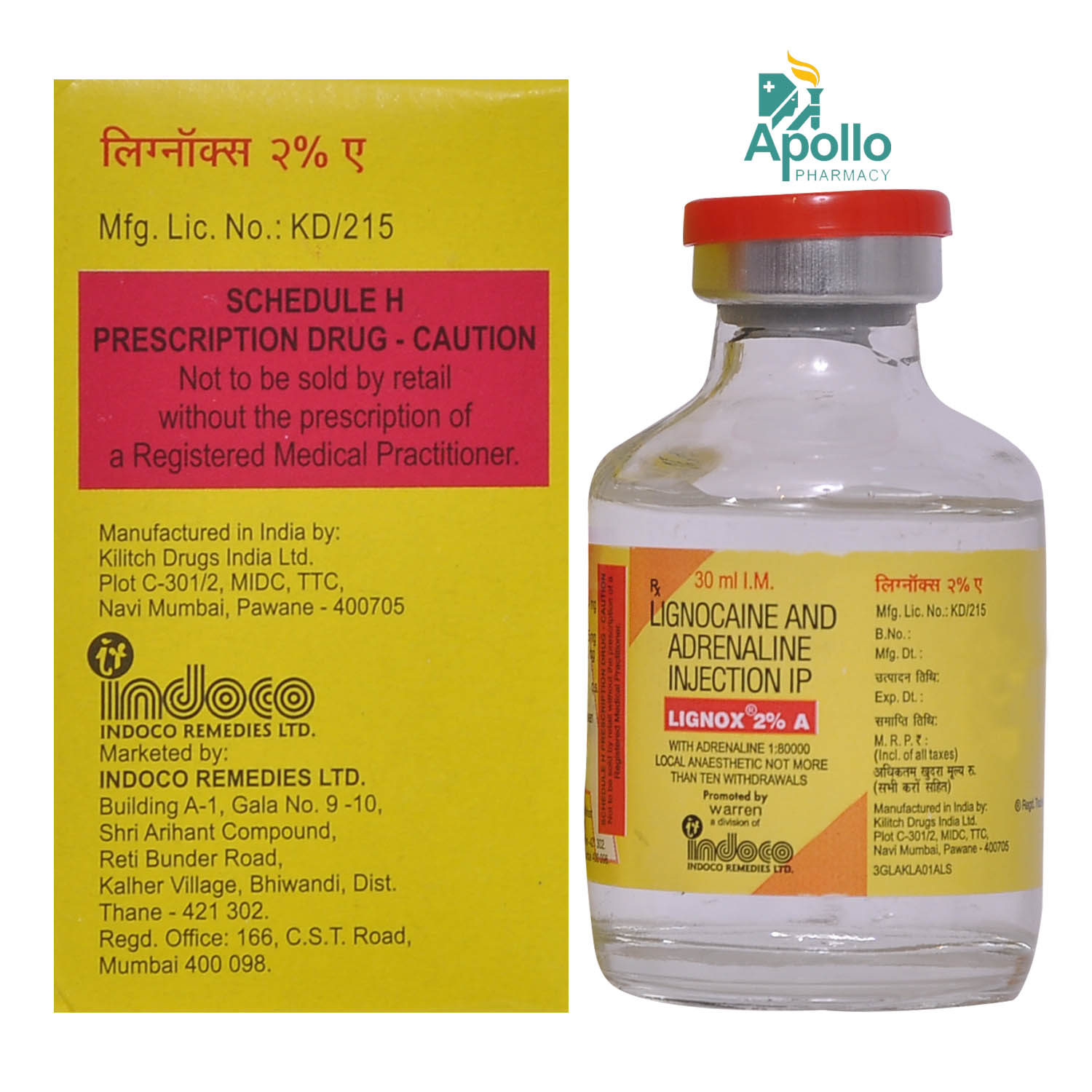Lignox 2% A Injection 30 ml




MRP ₹42.5
(Inclusive of all Taxes)
₹6.4 Cashback (15%)
Provide Delivery Location
Online payment accepted
 Prescription drug
Prescription drugWhats That
Composition :
Manufacturer/Marketer :
Consume Type :
Return Policy :
Expires on or after :
About Lignox 2% A Injection
Lignox 2% A Injection belongs to the class of local anaesthetics known as numbing medication used to produce local numbness (anaesthesia) on skin before surgical procedure and reduce pain and discomfort caused by invasive medical procedures such as surgery. It is also used to reduce the discomfort of contractions during labour. Lignox 2% A Injection is also used to treat certain types of chronic pain. Pain is a symptom triggered by the nervous system, which causes uncomfortable sensations in the body. Pain may be dull or sharp, it might be constant or may come and go. The tolerance level of pain might vary from person to person.
Lignox 2% A Injection is a combination of two drugs: Lidocaine (local anesthetic) and Adrenaline (vasoconstrictor). Lidocaine works by blocking the influx (entry) of sodium ions into the membrane that surrounds the nerves, thereby preventing initiation and conduction of impulses. Hence, it gives an anaesthetic effect and helps decrease the sensation of pain. Adrenaline works by constricting and narrowing blood vessels to slow the dispersal. Thereby prolong the effect of Lidocaine.
Lignox 2% A Injection will be administered by a healthcare professional. Do not self-administer. In some cases, you may experience certain common side-effects such as reactions at the application site (burning, itching, redness, and irritation), nausea, vomiting and allergy. Most of these side-effects do not require medical attention and will resolve gradually over time. However, you are advised to talk to your doctor if you experience these side-effects persistently.
The usage of Lignox 2% A Injection is not allowed in patients who are hypersensitive to any of the components present in it as it may cause serious side effects. Before starting the medication, tell your doctor about your medical history, especially if you have high blood pressure or heart problems such as a slow heart beat, hypovolaemia (decreased volume of blood), epilepsy, diabetes, liver disease, a certain blood disorder (methemoglobinemia). Please consult a doctor if you are pregnant or breastfeeding before taking Lignox 2% A Injection. Lignox 2% A Injection is not recommended for children.
Uses of Lignox 2% A Injection
Directions for Use
Medicinal Benefits
Lignox 2% A Injection is a combination of two medicines, namely; Lidocaine (local anesthetic) and Adrenaline (vasoconstrictor). Lignox 2% A Injection is used to produce local numbness (anaesthesia). Lidocaine is a local anesthetic which works by blocking the transmission of the nerve signals in the body, thereby helps in decreasing the sensation of pain. Adrenaline is a vasoconstrictor which works by constricting and narrowing blood vessels to slow the dispersal. Thereby prolong the effect of Lidocaine. Lignox 2% A Injection is used to reduce pain and discomfort caused by invasive medical procedures such as surgery, needle punctures or insertion of a breathing tube or catheter. It is also used to reduce the discomfort of contractions during labour. Lignox 2% A Injection will start to work rapidly after being injected and will slowly wear off when the surgical procedure is over.
Storage
Drug Warnings
Do not exceed the dose and duration prescribed by your doctor. Consult your doctor before taking Lignox 2% A Injection if you are pregnant or breastfeeding, your doctor will prescribe you Lignox 2% A Injection only if the benefits outweigh the risks. Lignox 2% A Injection causes drowsiness, so drive with caution. Avoid consuming alcohol along with Lignox 2% A Injection as it could lead to increased drowsiness. Lignox 2% A Injection may not be suitable for people with respiratory disease, heart disease, epilepsy, low blood pressure, kidney or liver problems. Inform your doctor about your health condition and medications before taking Lignox 2% A Injection to rule out any side-effects.
Drug-Drug Interactions
Drug-Drug Interactions
Login/Sign Up
Taking Lignox 2% A Injection 30 ml and Arbutamine together can affect the rhythm of your heart.
How to manage the interaction:
Taking Lignox 2% A Injection 30 ml with arbutamine is not recommended, but can be taken together if prescribed by a doctor. However, consult your doctor if you experience irregular heartbeat, chest tightness, blurred vision and nausea. Do not discontinue any medication without consulting a doctor.
Taking Lignox 2% A Injection 30 ml with Saquinavir can increase the blood levels of Lignox 2% A Injection 30 ml and cause an irregular heart rhythm.
How to manage the interaction:
Taking Lignox 2% A Injection 30 ml with Saquinavir is not recommended, but it can be taken together if prescribed by a doctor. However, consult your doctor if you experience sudden dizziness, lightheadedness, fainting and rapid heartbeat. Do not discontinue any medications without consulting a doctor.
Taking Flutamide with Lignox 2% A Injection 30 ml can increase the risk of methemoglobinemia (blood disorder in which too little oxygen is delivered to your cells).
How to manage the interaction:
Although taking Lignox 2% A Injection 30 ml and Flutamide together can evidently cause an interaction, it can be taken if your doctor has suggested it. However, consult the doctor immediately if you develop gray discoloration of the skin, abnormal blood coloration, nausea, headache, dizziness, lightheadedness, weakness, shortness of breath, rapid or shallow breathing, a rapid heartbeat, palpitation, anxiety, or confusion. Do not stop using any medications without consulting doctor.
Taking Conivaptan with Lignox 2% A Injection 30 ml may increase the blood levels of Lignox 2% A Injection 30 ml which increase the risk of serious side effects such as irregular heart rhythm and other cardiovascular problems.
How to manage the interaction:
Although taking Lignox 2% A Injection 30 ml and Conivaptan together can evidently cause an interaction, it can be taken if your doctor has suggested it. However, if you experience any unusual symptoms contact your doctor immediately. Do not stop using any medications without first talking to your doctor.
Taking Lignox 2% A Injection 30 ml with Cyclophosphamide may increase the risk of methemoglobinemia (a rare condition that can lead to oxygen deprivation in tissues and vital organs due to reduced oxygen-carrying capacity of the blood).
How to manage the interaction:
Although there is a possible interaction, cyclophosphamide can be taken with Lignox 2% A Injection 30 ml if prescribed by the doctor. However, consult the doctor if you experience gray discoloration of the skin, abnormal blood coloration, nausea, headache, dizziness, lightheadedness, weakness, shortness of breath, rapid or shallow breathing, a rapid heartbeat, palpitation, anxiety, or confusion. Do not discontinue the medication without consulting a doctor.
Taking Lignox 2% A Injection 30 ml and Metrizamide may increase the risk of causing seizures(fits).
How to manage the interaction:
Although taking Lignox 2% A Injection 30 ml and Metrizamide together can evidently cause an interaction, it can be taken if your doctor has suggested it. However, if you experience any unusual symptoms contact your doctor immediately. Do not stop using any medications without first talking to your doctor.
Combination of chloroquine and Lignox 2% A Injection 30 ml can increase the risk of methemoglobinemia (an uncommon disease that can result in low oxygen levels in tissues and important organs).
How to manage the interaction:
Taking chloroquine and Lignox 2% A Injection 30 ml together can possibly result in an interaction, it can be taken if your doctor has advised it. If you experience any of the following symptoms: gray discoloration of the skin, abnormal blood coloring, nausea, headache, dizziness, lightheadedness, weakness, shortness of breath, rapid or shallow breathing, rapid heartbeat, palpitations, anxiety, or confusion, consult your doctor
Taking Lignox 2% A Injection 30 ml with Prilocaine may cause methemoglobinemia (blood disorder in which too little oxygen is delivered to your cells).
How to manage the interaction:
Taking Lignox 2% A Injection 30 ml with Prilocaine together can possibly result in an interaction, but it can be taken if your doctor has advised it. However, consult the doctor immediately if you develop gray discoloration of the skin, abnormal blood coloration, nausea, headache, dizziness, lightheadedness, weakness, shortness of breath, rapid or shallow breathing, a rapid heartbeat, palpitation, anxiety, or confusion. Do not stop using any medications without consulting doctor.
Taking Lignox 2% A Injection 30 ml with Trimethoprim may cause methemoglobinemia (blood disorder in which too little oxygen is delivered to your cells).
How to manage the interaction:
Co-administration of Trimethoprim with Lignox 2% A Injection 30 ml can possibly result in an interaction, but it can be taken if your doctor has advised it. If you experience, gray skin color, feeling sick, having a headache, feeling dizzy or lightheaded, feeling tired, having trouble breathing, a fast or irregular heartbeat, feeling anxious or confused, contact your doctor right away. Do not stop using any medications without talking to your doctor.
Taking Lignox 2% A Injection 30 ml with hydroxycarbamide can increase the risk of methemoglobinemia (blood disorder in which too little oxygen is delivered to your cells).
How to manage the interaction:
Although taking hydroxycarbamide and Lignox 2% A Injection 30 ml together can possibly result in an interaction, it can be taken if your doctor has advised it. However, if you experience symptoms such as grey discolouration of the skin, abnormal blood colouration, nausea, headache, dizziness, lightheadedness, fatigue, shortness of breath, rapid or shallow breathing, a rapid heartbeat, palpitation, anxiety, or confusion, consult a doctor immediately. Do not discontinue any medications without consulting a doctor.
Drug-Food Interactions
Drug-Food Interactions
Login/Sign Up
Diet & Lifestyle Advise
- Indulge yourself in mindfulness activities like yoga that help in reducing stress levels and pain management.
- Never forget to get about 7-8 hours of sleep as it will help your muscles to heal fast and reduces inflammation and swelling.
- Take out some time for meditation, read books, take a warm bubble bath, spend time with family or listen to relaxing music.
- Make a habit of eating food rich in antioxidants such as berries, onion, milk, spinach, kidney beans, dark chocolate, etc.
- Foods rich in flavonoids helps the body to heal faster by reducing inflammation. These include soy, berries, broccoli, grapes and green tea.
- Strictly limit smoking and alcohol consumption as it may worsen the side effects of the drug.
Side Effects of Lignox 2% A Injection
- Pale skin
- Burning sensation
- Stinging sensation
- Erythema (skin redness)
- Itching
- Pain at the site of application
- Petechiae (red or purple spot caused by bleeding into the skin)
Habit Forming
Therapeutic Class
All Substitutes & Brand Comparisons
RX
Out of StockBiocaine ADR 24.64mg/0.0125mg Injection
Biochem Pharmaceutical Industries Ltd
₹32
(₹0.96/ 1ml)
25% CHEAPERRX
Out of StockExocaine Injection 30 ml
Idem Health Products Pvt Ltd
₹31.92
(₹0.96/ 1ml)
25% CHEAPER
Product Substitutes
Author Details
We provide you with authentic, trustworthy and relevant information
Drug-Diseases Interactions
Drug-Diseases Interactions
Login/Sign Up
FAQs
Lignox 2% A Injection contains Lidocaine and Adrenaline. Lidocaine blocks the influx of sodium ions into the membrane that surrounds the nerves, thereby preventing initiation and conduction of impulses (nerve signal). Hence, it gives an anesthetic effect and decreases the sensation of pain. Adrenaline works by constricting and narrowing blood vessels by acting on alpha receptors that cause muscle contractions. Thus, it decreasing the bleeding and the effects of Lignox 2% A Injection will last longer.
You are not recommended to take duloxetine (antidepressant) with Lignox 2% A Injection as co-administration of these two medicines may increase the risk of high blood pressure and heart rate. However, please consult your doctor before taking other medicines with Lignox 2% A Injection.
Lignox 2% A Injection causes drowsiness and vision disturbances. So, drive only if you are alert and omit driving or operating machinery if you feel dizzy or drowsy.
A person of age 65 or older should use Lignox 2% A Injection with caution, as directed by the doctor as the chances of occurrence of side effects increase in older people.
Lignox 2% A Injection should be used with caution in patients suffering from heart rhythm disorders as it may increase the risk of severe adverse effects. Therefore, inform your doctor if you have any heart problems before taking Lignox 2% A Injection so that the dose may be adjusted appropriately or an alternate medicine may be prescribed.
Drug-Drug Interactions Checker List
- LORAZEPAM
- ALPRAZOLAM
- HALOTHANE
- PRILOCAINE
- TRAMADOL
- AMIODARONE
- PROPRANOLOL
- SODIUM NITRITE
- DOMPERIDONE
- CIMETIDINE
- ISOCARBOXAZID
- PHENELZINE
- SELEGILINE
- TRANYLCYPROMINE
Special Advise
Inform your doctor about any blood diseases/problems like hypovolaemia (decreased volume of blood), heart problems such as a slow heart beat, difficulty breathing or ever had a stroke.
Disease/Condition Glossary
Pain is a symptom triggered by the nervous system, causing uncomfortable sensations in the body. Pain may be dull or sharp, it might be constant or may come and go. The tolerance level of pain might vary from person to person. Pain can be generalized (overall body aches) or localized (affecting a specific area of the body). Pain can be considered a good thing as it helps us know that something is wrong in the body and thereby helps diagnose the condition. The common causes of pain include headache, muscle strain, cramps, cuts, bone fractures, arthritis and stomach ache.

Have a query?
Buy best Anaesthetics products by
Neon Laboratories Ltd
Themis Pharmaceutical Ltd
Troikaa Pharmaceuticals Ltd
Samarth Life Sciences Pvt Ltd
Abbott India Ltd
Astra Zeneca Pharma India Ltd
Baxter India Pvt Ltd
Core Claris Lifesciences Ltd
Celon Laboratories Pvt Ltd
Ajanta Pharma Ltd
Miracalus Pharma Pvt Ltd
Torrent Pharmaceuticals Ltd
Zydus Cadila
AP Pharmaceutical
Fresenius Kabi India Pvt Ltd
Galpha Laboratories Ltd
Indoco Remedies Ltd
Anglo French Drugs & Industries Ltd
B Braun Melsungen AG
Cadila Pharmaceuticals Ltd
Claris Lifesciences Ltd
Dr Reddy's Laboratories Ltd
Elder Pharmaceuticals Ltd
Fortel Life Sciences
Hetero Healthcare Pvt Ltd
Icpa Health Products Ltd
Pure Derma Healthcare Pvt Ltd
Salve Pharmaceuticals Pvt Ltd
Sunways (India) Pvt Ltd
VARENYAM HEALTHCARE PVT LTD
Wockhardt Ltd
Zydus Healthcare Ltd
6Ipain Healthcare Pvt Ltd
Admac Lifesciences(Oncology)
Aesmira Lifesciences Pvt Ltd
Albatross Healthcare Pvt Ltd
Amwill Healthcare Pvt Ltd
Anchal Life Science Pvt Ltd
Atopic laboratories Pvt Ltd
Biovenice Criticure
Cellgen Biopharma
Cipla Ltd
Delvin Formulations (P) Ltd
Entod Pharmaceuticals Ltd
Ethinext Pharma
Foremost Marketing Pvt Ltd
Fusion Health Care Pvt Ltd
German Remedies Ltd
Global Dent Aids Pvt Ltd
Greycells Lifesciences Pvt Ltd
Himeros Pharmaceuticals Pvt Ltd
Ici India Ltd
Icpa Lab
Ikon Remedies Pvt Ltd
Intas Pharmaceuticals Ltd
Kopran Laboratories Ltd
Kshipra Health Solutions
Leeford Healthcare Ltd
MSP Pharmaceuticals
Medimarck Biotech
Modi Mundipharma Pvt Ltd
Mylan Pharmaceuticals Pvt Ltd
Optima Healthcare Solutions
Pericles Pharma
Pharmadent Remedies Pvt Ltd
Piramal Enterprises Ltd
Pristine Pearl Pharma Pvt Ltd
Questus Pharma Pvt Ltd
Ranbaxy Laboratories Ltd
Rusan Healthcare Pvt Ltd
Scott Edil Pharmacia Ltd
Skinocean Pharmaceuticals
Themis Chemicals Ltd
Themis Medicare Ltd
Ultra Drugs Pvt Ltd
Vhb Life Sciences Inc
Zee Laboratories Pvt Ltd
Alcohol
Caution
You are recommended to avoid alcohol consumption while taking Lignox 2% A Injection. Alcohol intake, along with Lignox 2% A Injection, may cause increased drowsiness.
Pregnancy
Unsafe
It is not recommended to take Lignox 2% A Injection while you are pregnant. Please consult your doctor if you have any concerns regarding this, your doctor will prescribe you Lignox 2% A Injection only if the benefits outweigh the risks.
Breast Feeding
Unsafe
Please consult your doctor if you have any concerns regarding this, your doctor will decide whether breastfeeding mothers can take Lignox 2% A Injection or not.
Driving
Caution
Lignox 2% A Injection may cause drowsiness and vision disturbances, do not drive or operate heavy machinery if you feel drowsy.
Liver
Caution
Lignox 2% A Injection should be used with caution in patients with liver impairment/liver disease. Dose adjustment may be needed. Please consult your doctor if you have a liver impairment or any concerns regarding this.
Kidney
Caution
Lignox 2% A Injection should be used with caution in patients with kidney impairment/kidney disease. Dose adjustment may be needed. Please consult your doctor if you have kidney impairment or any concerns regarding this.
Children
Unsafe
Lignox 2% A Injection should not be used by children, as the efficacy and safety have not been established.






